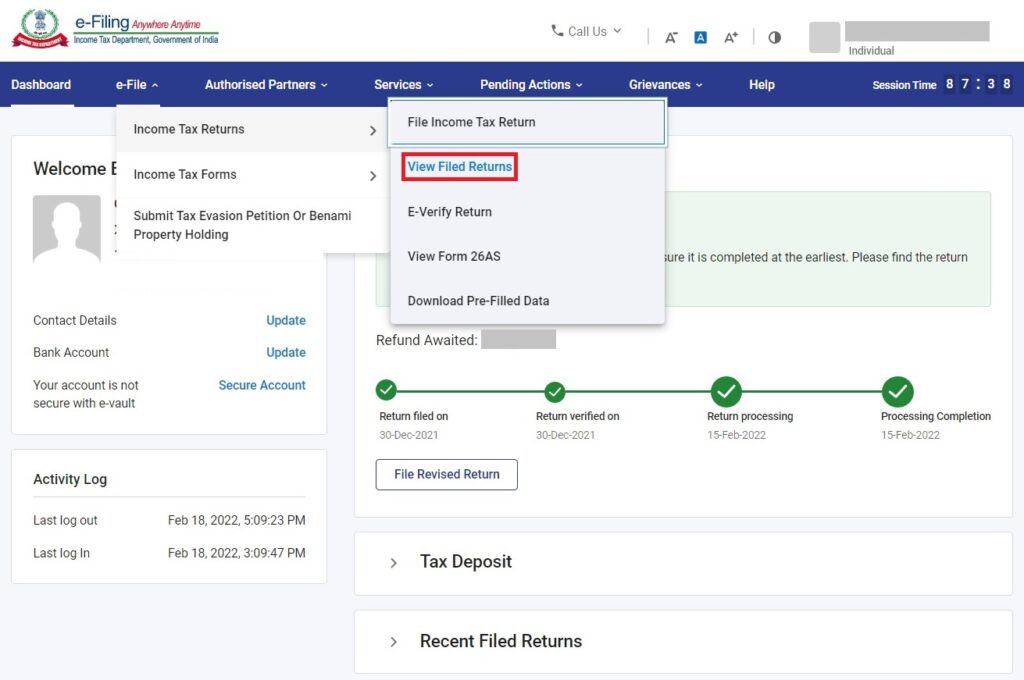The taxpayers’ income tax returns are first collected electronically at the Centralised Processing Centre (CPC). Following the processing of the refund, the IRS sends an intimation to the taxpayers under section 143 (1) of income tax informing them of the findings. Individuals with a certain amount of taxable income in India are required by law to file an Income Tax Return within a certain time frame, according to government regulations. An income tax return is a form or a set of forms that assists a taxpayer in disclosing his gross taxable income, deductions, and net tax liability from different sources. Salaried people, self-employed individuals, businesses, banks, Hindu Undivided Families, and others have to file income tax returns. By visiting the Income Tax Department’s website, you can file your income tax returns online. E-filing is the term used to describe the method of filing an income tax return electronically. Following e-filing, the Income Tax Department is responsible for handling the Income Tax Return applications. During the processing of the request, the Income Tax Department may discover inconsistencies in data, errors in calculations, incorrect entry of such data, and so on. The Department will issue a note, also known as an Intimation Order, in such situations. What is Intimation u/s 143(1)? The details submitted to the tax department and the details considered by the department to process the tax return are summarised in the Intimation u/s 143(1). The following are the details present in the Intimation u/s 143(1): Sequence number of refund Details of assesses, such as name, address, etc. As per Tax Department, the tax computed under section 143 (1) Other details related to Income Tax filing, such as filing date, acknowledgement number, etc. The tax calculation as provided in the Income Tax return Why is the Intimation u/s 143(1) Issued? Basically, when a return is submitted to the Income Tax Department, the department applies the following computerized checks as a part of its review procedure: An incorrect claim, which is apparent from any information in return. For example, if the deduction u/s 80C is claimed more than the maximum permissible deduction u/s section 80C i.e., Rs 1,50,000, the excess shall be disallowed and reflected in your intimation u/s 143(1). Another example may be that rent income is deducted from business income, which is not shown under Income from House Property. Disallowance of expenditure indicated in the audit report but not taken into account in computing the total income in the return Comparison of Advance Tax, Self-assessment tax and TDS, etc., from 26AS. Addition of income appearing in Form 26AS or Form 16A or Form 16 which is not included in ITR Claiming the losses for carry forward to next year when the return is submitted after the due date / set off of losses of the previous year where the return was filed after the due date. Whether deduction under section 10AA, 80-IA, 80-IAB, 80-IB, 80-IC, 80-ID, 80-IE has been taken after the due date of the Income Tax Return Calculation of Tax, Late filing fees, Interest, etc. When does one Receive Intimation on ITR? Discrepancies in the return filed When there is a difference between the sums you report and the records kept by the Income Tax Department, this condition will arise. You may have failed to report any of your earnings or given incorrect details. You will be notified by the Income Tax Department in certain situations. TDS error The most popular form of error with Income Tax Returns is the TDS number error. Your boss may have deducted money from your paycheck for TDS purposes in the past. You will get a notification from the IRS as a result of this. Document review The Income Tax Department may request a review of the documents on which a taxpayer has filed his Income Tax Returns in a variety of circumstances. The Department should submit an intimation to the taxpayer for this reason, and the taxpayer should reply promptly with the appropriate documentation. Declaration of investments made in name of spouse Many citizens want to purchase valuable assets such as property, fixed deposits, buildings, and other items under the names of their spouses or other immediate relatives in order to avoid paying taxes. These funds, on the other hand, belong to the owner and must be reported when filing an income tax return. Citizens will be notified by intimation from the Income Tax Department. Random Scrutiny The Income Tax Department may simply submit an intimation to the taxpayer to conduct a random audit of the records and data used to file Income Tax Returns. Under this situation, the taxpayer must work with the Department to supply them with all relevant information. Intimation u/s 143(1) Both income tax returns are processed to correct arithmetical errors, internal irregularities, tax estimation, and tax payment verification at the Intimation u/s 143(1) level. At this time, no income verification is carried out. It is done entirely by data engineering, with no human intervention. Types of Income Tax Intimations Intimation under 143(1) Income Tax Act- If an assessee has spent more or less than the sum he is currently entitled to pay, he will obtain intimation under Section 143(1). The assessee must make the payment and settle the problem if the payment is less than the real sum.In the event that he makes a reimbursement that is greater than the real sum, he will be notified of the refund amount by intimation. Notice under Section 142(1)- The Income Tax Department sends this notification with the purpose of collecting papers, books of accounts, or other written evidence in order to examine the assessee’s records and return. Notice under Section 143(2)- The Income Tax Department sends this notice to the assessee to remind him that his request for an income tax return will now be submitted for a thorough examination.This notice is normally submitted after the Notice under Section 142 has been sent (1). It indicates that the Assessing Officer has not acquired any valid documentation or that the collected documents are not








